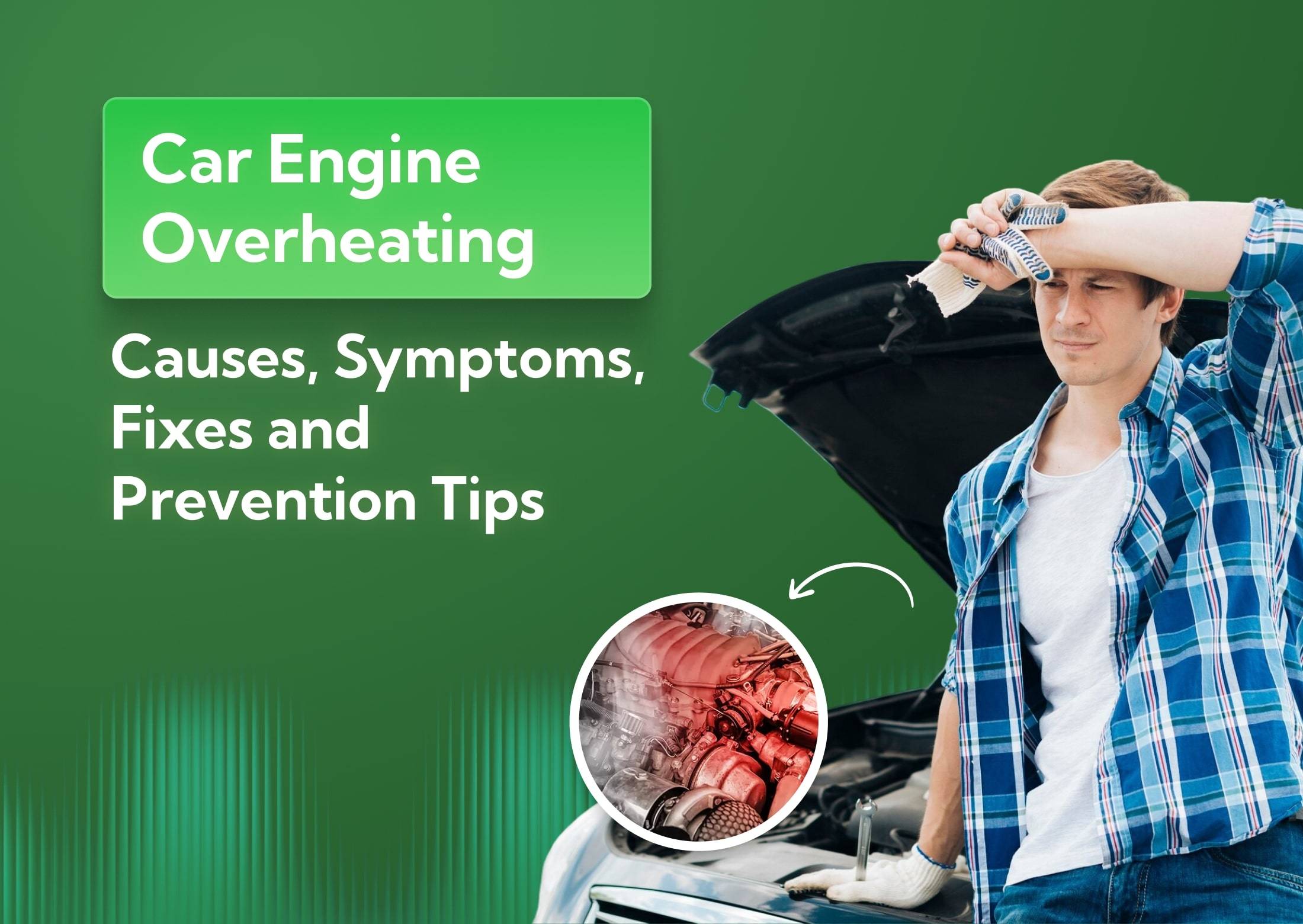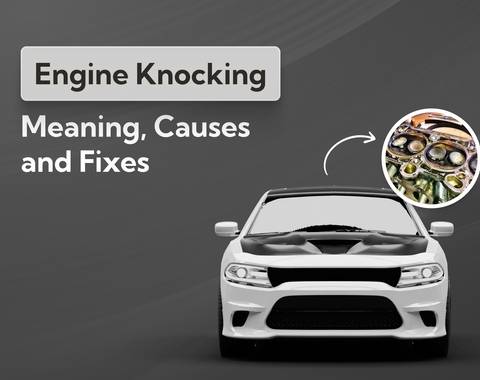Car Engine Overheating: Causes, Symptoms, Fixes and Prevention Tips
An overheating engine isn’t always a huge deal, but it certainly can be. In this guide, we’ll cover what causes engines to overheat, how to spot the warning signs early, the most effective fixes and repair costs and how to prevent it from happening again, so you can keep your car running smoothly and safely.
Last updated: 31st October, 2025

Award-winning automotive entrepreneur, tech innovator, and founder of Car.co.uk, NewReg.co.uk & Recycling Lives.

Listen to this story
Engines don’t just overheat out of nowhere. They do it because something’s gone wrong in the system that keeps them cool.
Maybe there’s not enough coolant circulating, maybe the thermostat’s jammed, or maybe the radiator fan’s just given up. Whatever the cause, once temperatures rise past normal, warped heads, blown gaskets and even full engine failure eventually follow.
The fix depends on what’s gone wrong. Sometimes it’s as simple as topping up coolant or replacing a hose. Other times, it’s a repair bill that makes you wonder if scrapping’s smarter.
Either way, catching it early and keeping up with basic maintenance (oil changes, coolant checks, regular servicing) is what keeps your engine from cooking itself in the first place.
In today’s guide, I’ll walk you through everything you need to know about car engine overheating: causes, symptoms, potential fixes and my best tips for prevention.
What's in this article
- 1. What are the main causes of engine overheating?
- 2. What are the symptoms of an overheating engine?
What are the main causes of engine overheating?
Engines overheat when heat can’t escape as fast as it’s being produced. It’s that simple.
The cooling system’s job is to absorb and move heat away and when any part of that process fails, temperatures spike. Common culprits include low coolant, a bad water pump, radiator blockages, a stuck thermostat and problems with the engine oil.
Let’s break all of those down.
Low coolant levels
Coolant does the heavy lifting in keeping your engine temperature steady. There are a few types:
- IAT (Inorganic Additive Technology): Older, green coolant used in cars built before the mid-1990s; needs replacing every 2 years.
- OAT (Organic Acid Technology): Common in modern vehicles; offers long-life corrosion protection (up to 5 years).
- HOAT (Hybrid Organic Acid Technology): A mix of IAT and OAT; also lasts around 5 years.
- P-HOAT (Phosphated HOAT): Popular in Asian cars like Honda, Toyota and Nissan.
- Si-HOAT (Silicated HOAT): Common in European vehicles like BMW, Mercedes and VW).
If yours is low, the system can’t carry heat away effectively, so the temperature climbs.
Leaks are the most common cause. They can be internal (radiator, hoses, water pump) or external (e.g. a cracked radiator or blown head gasket). Besides checking the coolant levels, look for puddles under the car, steam from the bonnet or a “low coolant” light on your dashboard.
The fix: Wait until the engine is completely cool, then top up the coolant to the “max” line using the correct mix of antifreeze and water (usually 50/50). Never open the cap while it’s hot; that pressure release can burn you.
Faulty water pump
The water pump keeps coolant moving through the system. When it fails (usually due to worn bearings or a snapped belt), the flow stops. That means hot coolant just sits in the engine, and overheating happens quickly.
If you hear a whining noise or spot coolant leaks near the front of the engine, that pump might be the problem.
The fix: Water pump replacement is usually a mechanic’s job, especially if the timing belt is what drives it. Expect to pay a few hundred pounds in labour and parts, but don’t ignore it — a failed pump can lead to catastrophic engine damage.
Radiator issues
Your radiator is like the engine’s air conditioner. It releases heat into the air. When it’s clogged, corroded or has a broken fan, that heat has nowhere to go. You might notice the temperature gauge creeping up in traffic (when there’s less airflow) but dropping again on the motorway. that’s a telltale sign of radiator trouble.
The fix: Check for debris blocking the radiator grille and clean it gently with compressed air or water. If the core is leaking or heavily corroded, it’ll need a professional repair or replacement.
Thermostat failure
The thermostat controls when coolant flows through the radiator. If it gets stuck closed, coolant can’t circulate and the engine overheats. If it’s stuck open, the opposite happens: the engine never reaches proper operating temperature, which hurts performance and fuel economy.
The fix: A stuck thermostat needs replacing. It’s a relatively inexpensive part, but getting to it takes time depending on your car model. A mechanic can confirm the fault and swap it out quickly.
Engine oil problems
Oil is a lubricant, but it also helps disperse heat. Low or dirty oil thickens, reducing its ability to flow and carry heat away. That means higher friction, low oil pressure and more heat trapped inside the engine. Keeping your oil clean and topped up is one of the easiest ways to prevent overheating.
The fix: Check your oil level regularly using the dipstick and top it up if you need to. Stick to the manufacturer-recommended oil grade and change the oil and filters every 5,000 to 7,500 miles, depending on your driving habits.
What are the symptoms of an overheating engine?
When your engine’s too hot, it’s not going to stay quiet about it. You’ll get visual, audible and even smellable signs that something’s off. The key is to catch those signs early before the damage becomes irreversible.
Broadly speaking, there are five things to look out for: a temperature gauge in the red zone, steam or smoke from the engine, dashboard warning lights, burning or sweet smells and reduced power when you start or accelerate.
Temperature gauge in the red zone
This is your first and most obvious clue. When the needle on your dashboard climbs into the red or you see the temperature light flash, it means the coolant isn’t keeping up. At this point, pull over safely, turn off the engine and let it cool down before doing anything else.
Once the bonnet has been closed for at least 15 to 30 minutes, check the coolant levels. Top up with the correct mix only once the system’s no longer hot to the touch. If the level’s fine but the gauge keeps spiking, call for roadside assistance because that’s a sign of a deeper issue.
Steam or smoke from the engine
If you see white steam escaping from under the bonnet, that’s coolant boiling over from overheating. If it’s dark smoke, that’s more serious and could mean burning oil or electrical issues.
Either way, stop immediately. Turn off the ignition, pop the bonnet latch (but don’t lift it yet) and wait. Once cool, check the coolant reservoir. Look for visible hose or radiator leaks. If you aren’t sure how to diagnose the issue, don’t risk driving any further.
Dashboard warning lights
Modern cars are good at warning you before things get critical. You might see a red temperature icon or a message like Engine Overheating. Sometimes the Check Engine light also comes on if sensors detect heat-related faults.
- If the light’s red, that means stop immediately.
- If it’s amber, that means address it soon.
If one turns on while driving, safely pull over and switch off the engine. You can turn the heater to max while waiting (it helps draw some heat away from the engine). Once it cools, check the coolant levels.
Top them up if they’re low and carefully drive to a repair shop. If you can’t see the cause or the light comes back on, call a tow truck instead.
Unusual smells (burning or sweet)
A sweet, syrupy smell usually means leaking coolant. A sharp burning odour indicates oil or plastic parts overheating. Both are bad news. If you smell either, pull over and shut the car down because the longer it runs, the worse the damage can get.
After cooling down, open the bonnet and look for leaks, melted plastic or burnt residue around hoses or the radiator. If you spot coolant dripping or oil residue, stay where you are because those leaks worsen quickly. Call for help and book a diagnostic check.
Reduced engine power
Practically all modern cars automatically enter ‘limp mode’ when temperatures rise too high. That’s the engine’s way of protecting itself. You’ll feel sluggish acceleration or power loss. This is why engine overheating will naturally cause a noticeable drop in engine power and fuel efficiency.
If you’re noticing this, turn off the car and wait 10 to 15 minutes so the computer resets. If you’re still having issues, check the engine and fluid levels. If topping up the fluid doesn’t work or if you notice something under the bonnet, you’re going to need a mechanic for a professional diagnosis.
What to do if your engine overheats?
If your dashboard alerts you or steam starts creeping out from under the bonnet, you don’t necessarily need to panic, but you do need to act fast. What you do in the next few minutes will make the difference between a quick fix and a totally ruined engine.
- Pull over safely. As soon as you notice overheating signs, find a safe place to stop (ideally away from traffic). Keep the engine running just long enough to reach a lay-by or the hard shoulder, then park, put it in neutral and apply the handbrake. Don’t try to “nurse” it home or you might permanently damage the engine.
- Turn off the engine. This prevents further heat build-up and stops moving parts from seizing. Keep the ignition key in position one (accessory mode) if you want the fans to keep running briefly without causing harm to the engine.
- Crank the heater. Turn it to full blast with the fan on high. Sounds odd, but it draws heat away from the engine and into the cabin air vents. It’s a short-term trick that can help bring temperatures down faster. Skip this step if the engine is already smoking heavily, coolant is visibly leaking or you smell something burning inside the cabin.
- Let the engine cool down. Patience is your friend here. Wait at least 15 to 30 minutes before touching anything under the bonnet. Opening it too soon will seriously burn you from hot steam or coolant. While you’re waiting, look for damp patches or puddles under the front of the car to rule out any obvious leaks.
- Check coolant levels. The coolant reservoir is a translucent tank marked with ‘min’ and ‘max’. If the level’s low, top it up with a 50/50 mix of antifreeze and distilled water. Avoid cold water straight from the tap because it can crack hot metal if the engine’s still warm. Skip this step and call a professional if you notice a leak anywhere under the bonnet.
- Do not open the hood immediately. Never lift the radiator or expansion tank cap while the engine’s still hot. Pressurised coolant can spray out at you and severely burn you. You’ll know it’s ready when the temperature gauge drops back to normal and you can rest your hand on the bonnet without discomfort.
If the car’s already smoking, there’s a serious leak and/or you notice significant damage under the bonnet, don’t try anything DIY. Unless it’s an easy fix (like a coolant top-up), call breakdown services instead.
What not to do when your engine overheats?
When your temperature gauge spikes, there are a few things you might be tempted to do that’ll only make the situation worse.
Here’s what not to do if your engine’s running hot:
- Don’t keep driving. This is the fastest way to turn a small problem into a massive repair bill. Driving with an overheated engine can warp the cylinder head, blow the head gasket or seize the engine completely. Even “just a few more miles” might cost you thousands.
- Don’t pour cold water on a hot engine. It might seem logical to cool it down fast, but sudden temperature changes can crack engine components. Metal expands when hot and contracts when cold and that shock can destroy your radiator, block or head gasket instantly. The only safe way is to wait.
- Don’t open the hood immediately. Hot engines build up intense pressure. If you pop the bonnet too soon, steam and boiling coolant can blast out and burn you and the rest of the engine. Wait until the temperature gauge drops back to normal and you can touch the bonnet comfortably before opening it.
- Don’t ignore the problem. Overheating almost always points to an underlying coolant leak, failing pump, clogged radiator or faulty thermostat. If you keep driving without finding the cause, it’ll happen again and next time, it might finish the engine for good.
Repair and replacement costs for overheated engines
Repair costs for an overheating engine can vary wildly from a simple £50 coolant top-up to several thousand pounds if the damage runs deep.
Minor fixes like replacing a thermostat or hose are usually in the £100 to £300 range. A coolant flush and refill typically costs £60 to £120. Radiator repairs or replacements can run between £250 and £700 depending on the make and model. For a new water pump, expect £300 to £800 fitted (on the higher end if it’s driven by the timing belt).
If overheating causes internal damage, that’s where it gets really painful. Then, repair isn’t an option and you have to go straight to replacement. A blown head gasket can easily top £800 to £1,500 and a full engine rebuild or replacement might exceed £5,000.
Coolant top-up and system replacement costs
A simple coolant top-up is cheap. It’s usually £10 to £30 if you do it yourself or £50 to £100 for a full flush and refill at a garage. That’s enough when levels are just low and there’s no leak.
But if your coolant keeps dropping or looks rusty or oily, it points to a deeper issue. A full cooling system replacement that includes the radiator, hoses, thermostat and water pump can cost £600 to £1,500 depending on the car.
And if you skip a full replacement when it’s needed, it’ll lead to repeated overheating, warped components and serious engine damage rather quickly.
Water pump replacement costs
In the UK, replacing a water pump typically costs between £250 and £700. The price varies because some pumps are easily accessible, while others are buried behind timing belts or chains that take hours to reach.
It also depends on your car’s make and model. It’ll be on the higher end for premium models or in major cities with higher labour rates, while smaller and more basic models will be on the lower end.
Since it’s not a cheap fix, it pays to know the warning signs early. Look out for coolant leaks near the front of the engine, a grinding or whining noise from the pump area and rising temperatures even when coolant levels are fine.
Radiator repair and replacement costs
If your mechanic says you just need a new radiator, expect to pay £200 to £700. The cost can vary based on what’s actually wrong. A minor leak is cheaper to fix than corrosion or a cracked core.
Small leaks in copper radiators can often be repaired, but modern aluminium and plastic ones are trickier. Repairs are sometimes possible if the damage is limited to plastic joints or the upper tank, but widespread leaks usually mean full replacement.
Since most new radiators fall toward the lower end of that range (under £400), I’d say it’s generally smarter and more reliable to replace rather than patch it up.
Head gasket replacement costs
Severe overheating can warp or crack the head gasket (the seal that keeps coolant, oil, and combustion gases separated). Once that happens, you’ll see white smoke from the exhaust, milky oil or bubbling in the coolant tank. Then a full head gasket replacement is unavoidable.
In the UK, expect to pay anywhere from £800 to £1,500, though head gasket replacement costs climb past £2,000 for high-end and tightly packed engines.
The repair is expensive because it’s labour-intensive. Mechanics have to dismantle a large portion of the engine to reach and reseal it properly. Ignoring it isn’t an option, either. If it’s even possible to drive with one, it’s extremely dangerous and will only cause more severe damage.
Is it worth repairing, replacing or scrapping your car after overheating?
When an engine overheats badly, the aftermath is expensive, and that’s where you have to make a decision: fix it, replace it or call it a day and scrap the car. The right choice depends on how bad the damage is, how much the car’s worth and how long you plan to keep it.
When it’s worth repairing the engine
If the damage is minor (like a bad thermostat or a radiator with a tiny leak), repair is almost always cost-effective. You’re looking at a few hundred pounds to get back on the road, which is a no-brainer unless the car’s practically worthless.
The only time it’s not worth it is if you’ve got a pile of other repairs waiting. If worn brakes, bald tyres and suspension issues are going to pile onto that in the next year, you’ll want to factor those costs in as well.
In my experience, if the car’s under 100,000 to 150,000 miles and in decent shape otherwise, fixing a small overheating issue is money well spent. It’s cheaper than replacing the car and keeps you running reliably for another few years.
When it’s worth replacing engine parts
If individual components are worn or damaged beyond repair (like a cracked radiator, seized pump or blown head gasket), replacement is the smarter move. You’ll spend more up front, but you’ll also extend your car’s lifespan and reduce the risk of future breakdowns.
Always go with a good mechanic and replace with genuine OEM parts. Cheap fixes here tend to fail early, which only puts you back in this position again later.
What the experts say

Anthony Sharkey
When scrapping the car is the better option
If the overheating caused major internal damage like warped cylinders, a blown gasket or total engine failure, the repair bill will exceed the car’s value if it’s older and has high mileage. In that case, it’s more sensible to scrap your car.
Use the “50% rule” as a guide: if repairs cost more than half the car’s current market value, it’s not worth it. Scrapping your car through our free service gets you instant cash and saves you from pouring money into a vehicle that’s reached the end of its life.
Preventive tips to avoid engine overheating
The reality is that overheating issues almost always result from skipped maintenance or small issues that snowball. A bit of regular care goes a long way.
Here’s what I always recommend drivers stay on top of if they want your engine to run cool and smooth all year:
Regularly check coolant levels.
Pop the bonnet once a month and make sure the coolant sits between the “min” and “max” lines on the reservoir. Low coolant is the most common cause of overheating and topping up takes less than five minutes.
Always check when the engine’s cold and use the correct antifreeze mix (generally 50% antifreeze, 50% distilled water).
Maintain your radiator and cooling system.
To keep your radiator and cooling system in top shape, start by giving them a quick visual check every month or two. Make sure there are no leaks, cracks, or buildup around the radiator cap or hoses. The radiator fins should be straight and free from debris like bugs, leaves, and road grime can block airflow and trap heat.
And have your coolant flushed and replaced every two to three years to prevent corrosion and blockages. You can buy a flush kit and do it yourself, or have a mechanic drain the system, flush it with cleaning solution and refill it with fresh coolant.
And as for the cooling system (hoses, clamps and all), have the whole thing inspected at least once a year so you stop leaks before they happen.
Replace the thermostat when needed.
The thermostat controls when coolant flows through the radiator to keep the engine within its ideal range. To keep it reliable, make sure your coolant is clean (sludge can cause sticking). But it does wear out with time, and the engine overheats when it sticks closed.
If your car takes longer than usual to warm up or the temperature gauge fluctuates erratically, that’s your cue. A new thermostat usually costs just under £200 fitted.
Get regular oil changes.
Oil helps cool the engine as much as it lubricates it. Old, dirty oil loses its ability to absorb heat, which raises overall temperatures. Stick to manufacturer-recommended intervals (every 5,000 to 7,500 miles) and use the correct grade. It’s a small expense that keeps your entire engine running cooler and healthier.
Monitor your engine temperature.
Get into the habit of glancing at the temperature gauge every so often, especially on long drives and in traffic. If it starts creeping higher than usual, pull over before it turns into a full-blown overheating episode. Think of that gauge as your early-warning system.
Drive responsibly in hot weather.
In high heat, avoid heavy acceleration, towing beyond your car’s limits and sitting idly with the air conditioning blasting. These all strain the cooling system. On long summer trips, plan rest stops to give the engine a breather. And keep some premixed coolant in the boot just in case.
Frequently asked questions
No, not even for a short distance. Once that temperature gauge climbs into the red, you risk serious engine damage. Continuing to drive can warp the head, blow the gasket or seize the engine entirely (and you don’t know when any of those things will happen).
Pull over safely, switch the engine off and let it cool, then check what’s going on under the bonnet.
It usually takes 15 to 30 minutes for an overheated engine to cool down, depending on the weather and how hot it got. Keep the bonnet closed during that time, otherwise you might expose yourself to steam and boiling coolant.
Once the bonnet’s cool to the touch and there’s no hissing or steam, you can safely inspect the system.
Yes, an overheating engine can cause permanent damage. Repeated or severe overheating can warp metal components, crack the cylinder head and damage the gasket seal. Even if the engine still runs afterward, hidden internal damage may already be done. Always have a mechanic inspect it because catching it early can save you from a full rebuild later.
You shouldn’t drive at all once your engine starts overheating. Even a few minutes can be enough to cause permanent harm. If you’re not near a safe spot to pull over, turn the heater to full blast while you coast to a stop. That’ll help draw some heat away from the engine just long enough to reach safety.
About Car.co.uk

Share on
Latest news & blogs










